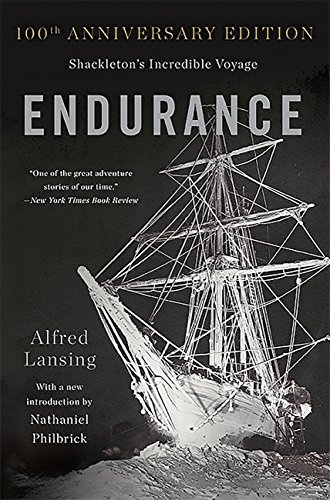The harrowing tale of British explorer Ernest Shackleton’s 1914 attempt to reach the South Pole, one of the greatest adventure stories of the modern age.
In August 1914, polar explorer Ernest Shackleton boarded the Endurance and set sail for Antarctica, where he planned to cross the last uncharted continent on foot. In January 1915, after battling its way through a thousand miles of pack ice and only a day’s sail short of its destination, the Endurance became locked in an island of ice. Thus began the legendary ordeal of Shackleton and his crew of twenty-seven men.
For ten months the ice-moored Endurance drifted northwest before it was finally crushed between two ice floes. With no options left, Shackleton and a skeleton crew attempted a near-impossible journey over 850 miles of the South Atlantic’s heaviest seas to the closest outpost of civilization. Their survival, and the survival of the men they left behind, depended on their small lifeboat successfully finding the island of South Georgia–a tiny dot of land in a vast and hostile ocean.
In Endurance, the definitive account of Ernest Shackleton’s fateful trip, Alfred Lansing brilliantly narrates the harrowing and miraculous voyage that has defined heroism for the modern age.
In the summer of 1914, Sir Ernest Shackleton set off aboard the Endurance bound for the South Atlantic. The goal of his expedition was to cross the Antarctic overland, but more than a year later, and still half a continent away from the intended base, the Endurance was trapped in ice and eventually was crushed. For five months Shackleton and his crew survived on drifting ice packs in one of the most savage regions of the world before they were finally able to set sail again in one of the ship’s lifeboats. Alfred Lansing’s Endurance: Shackleton’s Incredible Voyage is a white-knuckle account of this astounding odyssey.
Through the diaries of team members and interviews with survivors, Lansing reconstructs the months of terror and hardship the Endurance crew suffered. In October of 1915, there “were no helicopters, no Weasels, no Sno-Cats, no suitable planes. Thus their plight was naked and terrifying in its simplicity. If they were to get out–they had to get themselves out.” How Shackleton did indeed get them out without the loss of a single life is at the heart of Lansing’s magnificent true-life adventure tale.
The harrowing tale of British explorer Ernest Shackleton’s 1914 attempt to reach the South Pole, one of the greatest adventure stories of the modern age.
In August 1914, polar explorer Ernest Shackleton boarded the Endurance and set sail for Antarctica, where he planned to cross the last uncharted continent on foot. In January 1915, after battling its way through a thousand miles of pack ice and only a day’s sail short of its destination, the Endurance became locked in an island of ice. Thus began the legendary ordeal of Shackleton and his crew of twenty-seven men.
For ten months the ice-moored Endurance drifted northwest before it was finally crushed between two ice floes. With no options left, Shackleton and a skeleton crew attempted a near-impossible journey over 850 miles of the South Atlantic’s heaviest seas to the closest outpost of civilization. Their survival, and the survival of the men they left behind, depended on their small lifeboat successfully finding the island of South Georgia–a tiny dot of land in a vast and hostile ocean.
In Endurance, the definitive account of Ernest Shackleton’s fateful trip, Alfred Lansing brilliantly narrates the harrowing and miraculous voyage that has defined heroism for the modern age.












